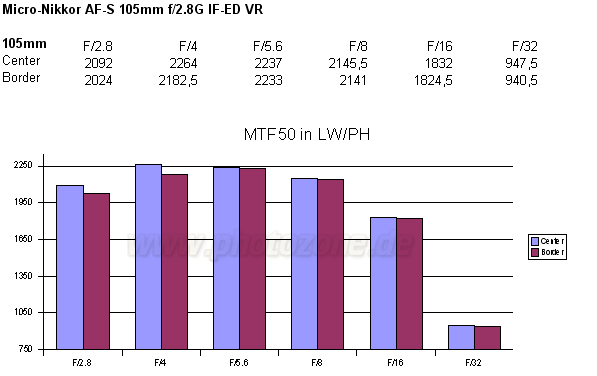diffraction
Feb 15, 2013 20:17:07 #
silver
Loc: Santa Monica Ca.
The image on the right is shot with an F stop of F8 and the image on the left is shot at F22. Camera was on a heavy tripod and the exposures were made using live view with a cable release so the sharpest images could be achieved. If you study the two images the image on the left has greater depth in the image but the over all sharpness of the image is degraded. The image in the right has less depth but the sharpness of the image is considerably greater. These sample images were shot with a Nikon 60mm Macro lens using a D800E camera. So the conclusion is that you have two choices when considering which F stop to use. F8 is the sweet spot setting of the lens because the maximum opening of the lens is 2.8 so thats 3 stops down and that is where the lens performs at its sharpest or you can close down the F stop to F 22 and lose the high quality sharpness and have greater depth. Personally I would go for the over all best quality and use F 8, maybe F 11 at the maximum. These images are shown at 100% enlarging so the effects of diffraction can be clearly seen.

Feb 15, 2013 22:04:39 #
Feb 16, 2013 03:46:27 #
This is exactly why the focus-stacking capture technique, and merging programs were developed.
FAQ: Why are my Digital Images Sharper at f/8 than f/22?
http://www.uglyhedgehog.com/t-59819-1.html
FAQ: What is Focus-Stacking, and What Programs are Required?
http://www.uglyhedgehog.com/t-50561-1.html
FAQ: Why are my Digital Images Sharper at f/8 than f/22?
http://www.uglyhedgehog.com/t-59819-1.html
FAQ: What is Focus-Stacking, and What Programs are Required?
http://www.uglyhedgehog.com/t-50561-1.html
Feb 16, 2013 03:51:53 #
for me the sharpness difference of these two images is hardly noticeable but the depth of field is. higher f stop for me for macro.
Feb 16, 2013 06:21:47 #
Go for depth of field.
Diffraction of little significance in the real world.
How big a print do you want?
Diffraction of little significance in the real world.
How big a print do you want?
Feb 16, 2013 06:32:34 #
F22 shot on same focal plane as subject far out ways the diffraction. F/25 and beyond you really start seeing the deterioration of the photo thru diffraction Until you've done macro you have not really tested your theory, Diffraction//DOF. Most will choose the DOF
silver wrote:
The image on the right is shot with an F stop of F... (show quote)
F/22 with tubes. At F/8 only one spider and only eyes would be in focus

F/14 again the results at F/8 would have left on of the subject out of focus

Feb 16, 2013 06:54:53 #
Feb 16, 2013 07:29:28 #
silver wrote:
... If you study the two images the image on the left has greater depth in the image but the over all sharpness of the image is degraded. ... These images are shown at 100% enlarging so the effects of diffraction can be clearly seen.
Good observation. Like everything else in photography, there is a tradeoff between depth of field and diffraction.
Diffraction will begin to show up at about F/22 for a 35mm full-frame image, see http://www.cambridgeincolour.com/tutorials/diffraction-photography.htm. This link contains a handy calculator that shows that it is actually a problem at f/16 for a sensor with a crop factor of 1.5.
Diffraction does not appear suddenly at a specific aperture. The calculator shows that it is independent of focal length but depends on the film format or sensor size.
Norman Koren also gives a thorough mathematical explanation of this in http://www.normankoren.com/Tutorials/MTF6.html although the math may a bit tough to slog through.
He states that "The sweet spot the range of apertures with excellent sharpness, tends to be between f/5.6 and the aperture corresponding f/11 for the 35mm [full frame] format..." so your selection of f/8 is consistent with his recommendation.
Feb 16, 2013 09:50:44 #
silver wrote:
The image on the right is shot with an F stop of F... (show quote)
As dubach says, the differenc of sharpness isn't that great. The reason why there is any difference at all is almost certainly due to the fact that your focussing for the upper right part was more accurate for f/8 image. A bit more care with the f/22 would have have broughit up to scratch.
I don't think that anything you are seeing is caused by diffraction. Diffraction only occurs at very small apertures and the reason that DSLR and compact apertures are restricted to f/22 is that it is OK.
With lenses of greater size, made for medium format or, even more so, big plate cameras then diffraction is less of a problem. Rember that the Adams / Weston group was called f/64!!! Their cameras could take it, and gave great depth of field.
GHK
Feb 16, 2013 10:11:05 #
silver
Loc: Santa Monica Ca.
GHK wrote:
quote=silver The image on the right is shot with ... (show quote)
Focusing was not changed for any of my test shots. You are wrong about diffraction, with 35mm lenses diffraction begins at F11. Not true about large format lenses either. The luminous landscape has a very good discussion about this subject. See this site http://www.luminous-landscape.com/tutorials/understanding-series/u-diffraction.shtml. This is not my theory or an opinion, this is a fact of lens performance. The F64 club was formed before the diffraction quality of lenses was recognized. I am not saying that diffraction is bad, I am just pointing out that diffraction exists and it should be taken into consideration when making images.
Feb 16, 2013 10:17:40 #
silver
Loc: Santa Monica Ca.
fstop22 wrote:
F22 shot on same focal plane as subject far out wa... (show quote)
This is not a theory, it is a proven fact. I am just passing on information that I have found over the years. I have done quite a bit of macro work and its fun. Please see the enclosed article from the Luminous Landscape. http://www.luminous-landscape.com/tutorials/understanding-series/u-diffraction.shtml. I am just pointing out something that people may not know about and if you are doing photography this should be common knowledge.
Feb 16, 2013 11:34:58 #
silver wrote:
. with 35mm lenses diffraction begins at F11. Not true about large format lenses either. The luminous landscape has a very good discussion about this subject. See this site http://www.luminous-landscape.com/tutorials/understanding-series/u-diffraction.shtml. ...
Actually, diffraction begins at wide open but the ratio of diffracted light to un-diffracted light only becomes a problem as you reach the diffraction limit. The calculator on that link clearly illustrates this.
For a full-frame 35mm SLR/DSLR the diffraction limit is somewhere between f/16 and f/22. It is lower for a crop sensor DSLR and higher for larger formats, as high as f/90 for 8x10.
For some reason, the link above may not work. Try instead: http://www.cambridgeincolour.com/tutorials/diffraction-photography.htm#calculator This link shows a diffraction limit between f/22 and f/32 for 35mm.
However, as with everything else in photography, it is a matter of degree. The diffraction limit is the point at which the Diameter of Airy Disk exceeds the diameter of the Maximum Circle of Confusion. So, if you assume a larger circle of confusion, you end up with a higher f-stop for the diffraction limit.
There are, of course, a lot of other assumptions you need to consider such as print dimension, viewing distance, your eyesight and camera resolution. Click on advanced to see all of these in the calculator.
Feb 16, 2013 12:38:34 #
GHK wrote:
Your assumptions are not correct. Silver is correct about measurable resolution fall-off starting just after "the sweet spot" of any lens. The reason why there is any difference at all is almost certainly due to the fact that your focusing for the upper right part was more accurate for f/8 image. A bit more care with the f/22 would have have brough it up to scratch.
I don't think that anything you are seeing is caused by diffraction. Diffraction only occurs at very small apertures and the reason that DSLR and compact apertures are restricted to f/22 is that it is OK.
I don't think that anything you are seeing is caused by diffraction. Diffraction only occurs at very small apertures and the reason that DSLR and compact apertures are restricted to f/22 is that it is OK.
The sharpness of a photographic imaging system or of a component of the system (such as the lens) is characterized by a parameter called Modulation Transfer Function (MTF). Here is the MTF chart for my Nikkor 105G macro lens.
Nikon 105G Resolution chart

Feb 16, 2013 12:58:07 #
Nikonian72 wrote:
quote=GHK The reason why there is any difference ... (show quote)
This is the primary factor that led me to focus stacking, where I almost always choose f/5.6.
For hand-held, of course one, must sometimes choose diffraction over (loss of) DOF.
It has been my experience that "significant" diffraction begins around f/11 and the "true sweet spot" is f/5.6. Diffraction tests on some lenses are available at slrgear.com.
Feb 16, 2013 16:30:56 #
I doubt very much if you've done much Macro work.. Please post photos showing where F/8 Out shines the same image at F/22. You are Correct in saying it is Not a Theory, Put if I drive my car on an oval shape race track with no wind, newly washed and waxed and I'm leaning forward in my car seat I will get 22 MPG.. Now if I drive the same car, give it gas to pass, race up and down the street, climb hills and valleys I will get 20 MPG Now this is Not theory, put Fact.. Who Takes Single shot macros for DOF and Uses F/8???? Nobody.. Nobody. Without apertures above F/8 You Have No DOF/very little/macro only/ especially if your doing macro and your working distance is 6 inches. As we all know the closer to subject the less DOF you have. Now show me a Single Shot Macro that you've done with Lots of DOF shot at F/8 to F/2.8. I'm a field Photographer, one that actually goes out in the field and shoots. If I took everything I read do heart, then I would not even shoot as everything is Not Perfect. Please show me some great macro shots taken at MWD with good DOF at F/8
silver wrote:
quote=fstop22 F22 shot on same focal plane as sub... (show quote)
If you want to reply, then register here. Registration is free and your account is created instantly, so you can post right away.







